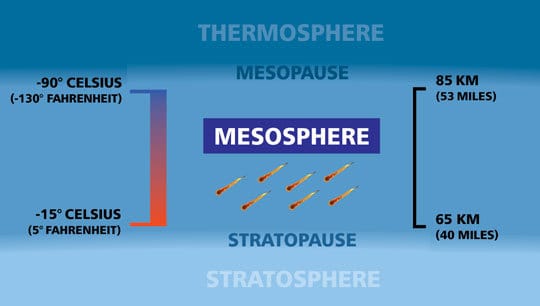Facts About The Exosphere: The Outermost Layer Of The Atmosphere

The Earth's atmosphere consists of five distinct layers, each with its own unique features. We examine what precisely the outermost layer, the exosphere, is and what its defining characteristics are.
The exosphere is the fifth and outermost layer of Earth's atmosphere, situated above the thermosphere at altitudes of 500 to 1 000 km, or 311 to 620 miles, extending to 10 000 km or 6 200 miles. It is the layer where any remaining properties of Earth's atmosphere transition into Outer Space.
When viewed from the surface or low Earth orbit, our atmosphere seems to be one continuous layer of air. However, it consists of five different layers: The troposphere, stratosphere, mesosphere, thermosphere, and exosphere.
This article focus on the exosphere, the outermost layer of the atmosphere. It not only examines what the exosphere is but also looks at the characteristics or facts that define it.
Exosphere Definition

It was already briefly described during the introduction, but in order to examine the exosphere in more detail, a more comprehensive definition is required.
What Is The Exosphere?

The exosphere is the fifth and outermost layer of Earth's atmosphere. It is situated above the thermosphere at an altitude of 500 - 1 000 km (311 - 620 miles) and extends to 10 000 km (6 200 miles). The exosphere's lower boundary is also known as the exobase.
It is the atmospheric layer where any remaining properties of Earth's atmosphere transition into outer space. It mostly contains light gas molecules like hydrogen and helium, but also carbon dioxide & oxygen lower near the exobase. It is also home to the Hubble Space Telescope.
The name "exosphere" is derived from Ancient Greek, with "ἔξω éxō" meaning "outside," and "σφαῖρα sphaĩra" meaning "sphere." Directly translated "outside sphere" perfectly describes the exosphere since it is the Earth's outermost layer in a spherical shape.
The exosphere is situated just above the thermosphere, with a thin layer of air called the thermopause separating the two layers. It reaches up for thousands of miles and seamlessly merges with the vacuum of space, where all Earth's atmospheric characteristics disappear.
It does not have a fixed lower boundary but starts at an altitude of approximately 500 - 1 000 km(311 - 620 miles), extending up to a height of roughly 10 000 km (6 200 miles). It also has no clear upper boundary.
The lower boundary is also called the exobase. The exobase is also known as the "critical altitude." Above this height, temperatures remain relatively stable, and barometric conditions are no longer relevant.
Compared to the four layers below it, the exosphere contains little to almost no traces of the characteristics that define the Earth's atmosphere. In fact, the "air" so thin that it resembles interplanetary space more than it does the rest of Earth's atmosphere.
(Gas molecules can travel for hundreds of miles without ever coming into contact or colliding with another particle.)
What sets the exosphere really apart, though, is the fact that small particles in the layer do not react the same as in other atmospheric layers where gas molecules mix and collide with each other.
The few molecules present in the layer basically never collide. Instead, they enter the exosphere and typically follow a ballistic trajectory, which after reaching their apex (maximum altitude), curve back down and reenter the lower atmosphere.
(Some small particles travel too fast, though, and manage to break free from the Earth's gravitational pull and escape into space. As a result, smaller particles are continuously escaping the planet's atmosphere.)
The small number of gas molecules present in the exosphere is mostly light gases such as hydrogen and helium. Heavier gas molecules like carbon dioxide and oxygen can be found closer to the exobase.
Temperatures can easily exceed 2 000° Celsius (3 632° Fahrenheit) in the exosphere, but there are no particles to transfer the heat, so one will never experience it. In fact, if exposed, one will experience the typically freezing cold temperatures of outer space in the exosphere.

As a result of its vastly different characteristics compared to the other atmospheric layers, it should come as no surprise that some scientists don't regard the exosphere as part of the atmosphere at all and see the thermosphere as Earth's uppermost layer.
Due to its altitude and composition, the exosphere is home to a large number of navigational, communication, and weather satellites. Its most famous inhabitant, though, is the Hubble Space Telescope.
Earth is not the only planet in our solar system that has an exosphere. Jupiter, Mars, and Saturn are just two examples of other planets also having exospheres.
(Even smaller satellites that do not have atmospheres containing a mix of gases, like the moon and three of Jupiter's moons, have what is called a "surface boundary exosphere.")
Facts About The Exosphere
The following list highlights the characteristics and facts of the exosphere in more detail.
- 1The exosphere is the fifth and outermost layer of Earth's atmosphere.
- 2It is situated above the thermosphere at an altitude of 500 - 1 000 km (311 - 620 miles) and extends to 10 000 km (6 200 miles).
- 3It has no clearly defined lower and upper boundary.
- 4The exosphere is situated just above the thermosphere, with a thin layer of air called the thermopause separating the two layers.
- 5The lowest part of the exosphere is also known as the exobase.
- 6In the exosphere, the air is so thin and contains so few particles that it only makes up 0.002% of the total mass of the Earth's atmosphere.
- 7The relatively few gas molecules present in the layer basically never collide and follow a ballistic trajectory through the exosphere.
- 8Temperatures can exceed 2 000° Celsius (3 632° Fahrenheit) in the exosphere, but there are no particles to transfer the heat, so one will never experience it.
- 9The exosphere is home to the Hubble Space Telescope and a large number of communication and weather satellites.
- 10Light atmospheric gases like hydrogen and helium are the most abundant in this layer, with a few heavier gases like carbon dioxide and oxygen present close to the exobase.
- 11A number of scientists don't regard the exosphere as one of the atmospheric layers and view the thermosphere as Earth's outermost layer.
- 12Other planets in our solar system like Jupiter, Saturn, and Mars also have exospheres.
This is by no means a comprehensive and exhaustive list that contains all the data available about the exosphere but highlights the key facts and characteristics that define this layer.
Conclusion
As this article highlighted, the exosphere still contains small of the gases present in the other four atmospheric layers, but these quickly disappear as altitude increase and the last traces of the atmosphere transition into the vacuum of space.
It is not surprising, then, that many scientists argue that the exosphere cannot be considered part of Earth's atmosphere and that the thermosphere constitutes the atmosphere's upper boundary.
It is technically still part of the atmosphere, though, and contains a small percentage of the gases found closer to the planet's surface. And, yes, it still has an important role to play, as just illustrated.
If you are interested in the complete structure and make-up of the atmosphere, this article covers all five atmospheric layers and their relation to each other in more detail.
Never miss out again when another interesting and helpful article is released and stay updated, while also receiving helpful tips & information by simply clicking on this link .
Until next time, keep your eye on the weather!
